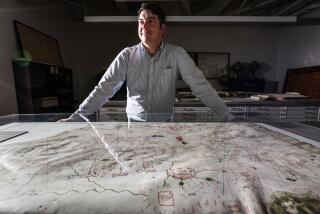How the marine compass finally found its sea legs
- Share via
Since its first documented use by the Chinese centuries ago, the magnetic compass has guided countless sailors safely across the seas. Though the compass allowed for the advent of modern navigation, early versions could often be wildly imprecise, giving a false sense of security to seafarers and leading to disastrous consequences.
The device’s rocky evolution is charted with an enthusiast’s passion in “Compass” by British yacht designer, writer and photographer Alan Gurney, who chronicles the instrument’s history from the discovery of the lodestone’s magnetic properties to the development of global positioning systems, with a focus on the British role in compass development.
It is a fascinating adventure, marked by folly, ingenuity, epic shipwrecks and the loss of innumerable lives. The compass was considered so precious to northern seamen of the 16th century, Gurney tells us, “that any man found tampering with the compass or its magnetizing lodestone had his hand, by law, pinned to the mast with a dagger, the even more painful result being a split palm as the offender, to gain freedom, dragged his hand down against the blade.”
Beginning with the cry “Breakers ahead!,” Gurney tells of the 1707 night when four ships of the British Royal Navy fleet were pounded to bits on the Scilly Islands’ granite reefs in the gateway of the English Channel. Two thousand men drowned; the loss that night is still considered one of the worst shipwrecks suffered by the Royal Navy. That disaster, readers learn, was due to a number of factors, particularly the use of “shoddy compasses.”
In fairly accessible terms, Gurney explains how the compass works, describing the magnetizing properties of the gray-black ore lodestone; telling of the distorting effects on the magnetized needle by other iron in its vicinity, including iron-hulled ships; and detailing the many devices and theories invented over the years to compensate for this magnetic deviation. The difference between true north and magnetic north is considered as we learn of the inventive ways early compass designers tried to countermand their instrument’s fallibility.
For many years in Britain, the most popular compasses were dry, designed with a magnetized needle set in a glass-covered wood or brass bowl.
“As sailing ships have a horrid tendency to roll and pitch in a seaway, the compass bowl was hung in gimbals (double pivoted rings) to keep the compass card as horizontal as possible.” These dry compasses were often inexact and nearly impossible to read on pitching seas.
After the Scilly Islands shipwreck, for example, the remaining fleet’s compasses were hauled in and inspected; the resulting report was dismal. “Of 136 wood-bowl and 9 brass-bowl compasses, only 3 were found effective.” Much of Gurney’s narrative details how, through a combination of political machinations by the elite and myriad stopgap measures by compass makers themselves, the dry compass remained in the British navy’s favor for years, even as the fleets of other nations moved on to the liquid compass.
Detailing the many tumultuous stages and wrong turns taken along the way, Gurney leads up to the refinement of the marine magnetic compass we’re used to seeing today, a “liquid” compass in which the compass card floats in liquid (usually a mix of water and alcohol) to dampen the card’s movement. This design is similar to the earliest compasses from centuries ago, in which a magnetized needle floated in a bowl of water.
Serving as a bookend to Gurney’s in-depth and at times technical history is an anecdotal story from the recent past. In 1998, he writes, a very expensive yacht was going through its sailing trials. The instrumentation aboard was like something out of a James Bond movie, with flickering digital numbers and glowing screens tied into orbiting satellites. “No inconvenient and cumbersome charts, tide tables, parallel rules, plotters, dividers, or pencils cluttered this altar to modernity.” The first night at sea -- moonless, starless -- all the electronic instruments failed as a result of a defective switchboard. There was no old-fashioned compass on board, so the crew members were reduced to sailing blind with no directionals other than the wind, an experience, Gurney tells us, that took them back a thousand years.
For all the technological advances that have made sailing a safer activity since the compass was refined -- the gyrocompasses, fluxgate compasses and global positioning systems -- Gurney reminds us, “the marine magnetic compass, the sailor’s guide, remains the essential instrument when all the others have failed.”

